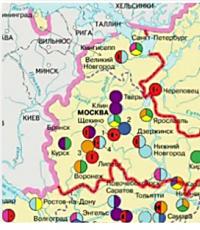Characteristics of the employee for the award. What is the characteristic for awarding a certificate of honor? Range of products sold
1. General information
1.1. Name legal entity(full and short name), certificate of registration with the tax authority (TIN), certificate of state registration enterprise (OGRN), address (legal and actual), operating hours. Location (free-standing, built-in, built-in, etc.). Availability of a sign indicating the legal form and operating hours.
1.2. Availability of information for consumers (address and telephone number of a higher organization, as well as contact telephone numbers of regulatory authorities, Law Russian Federation“On the protection of consumer rights”, rules, etc.).
1.3. Store area (explication of BTI and (or) information and reference document reflecting the number of premises and their area), trading floor, number of staff.
1.4. Availability of the program production control, its implementation, maintaining audit trails. Order on the appointment of an employee responsible for organizing and implementing production control. Availability of an agreement with an accredited laboratory for laboratory research and instrumental measurements (with a multiplicity of established by the requirements regulatory documents). Availability of laboratory research protocols. Personnel training as part of production control.
1.5. Assortment list of products sold. Compliance of the range of products sold with existing capabilities, the range of premises, the availability of retail and refrigeration equipment enterprises.
1.6. Compliance Federal Law from 02/23/2013 No. 15-FZ "On protecting the health of citizens from the effects of environmental tobacco smoke and the consequences of tobacco consumption."
2. Range of products sold
2.1. List of goods sold:
2.1.1.by product name (how many total product names are on sale, of which the number of names of toys, clothes, shoes, children's cosmetics, stationery, etc.);
2.1.2. by origin (country of origin, for example, toys produced in China account for 30% of the total number of toys sold, Russia - 50%, etc.).
2.2. List of products sold that are subject to state registration (names of products).
2.3. List of suppliers (name of the legal entity (full and abbreviated name), actual and legal address, telephone number, full name of the manager, names of goods purchased from this supplier).
3. Compliance with the requirements for the layout, placement, arrangement and sanitary condition of premises
3.1. Improvement of the territory of the trade organization and the adjacent perimeter territory.
3.2. Availability of a waste collection area: sanitary maintenance, number of waste containers. Garbage removal agreements. Availability of bins for collecting waste and garbage in the store premises.
3.3. Availability of a storage area for used fluorescent lamps: sanitary maintenance, conditions for collection and storage of fluorescent lamps. Agreement for the removal and disposal of fluorescent lamps, work acceptance certificates. Storing a stock of new fluorescent lamps.
3.4. Compliance with water supply and sewerage requirements (availability of sanitary facilities for staff and visitors, equipment and sanitary condition).
3.5. Compliance with requirements for ventilation, air conditioning, heating of premises (availability of documents confirming the serviceability, efficiency and maintenance of ventilation and air conditioning systems, including disinfection).
3.6. Compliance with requirements for natural and artificial lighting of premises.
3.7. Sanitary and sanitary-technical maintenance and condition of the facility. Finishing of premises, need for repair work.
3.8. Reception (loading) of goods (separate entrance, availability of special loading rooms, storage area). Maintaining flow (receipt and sale of food and non-food products, separate entrances for staff and visitors).
3.9. Set of premises, availability of trade departments (sanitary and technical condition of premises, refrigeration, trade and technological equipment).
4. Compliance with the requirements for equipment and inventory.
4.1. Equipping the organization with commercial, refrigeration, technological equipment, inventory, containers, and packaging materials.
4.2. Availability of measuring instruments for monitoring the temperature and humidity conditions of storage of products sold.
4.3. Compliance with the cleaning regime for commercial equipment.
5. Compliance with requirements for reception and storage.
5.1. Acceptance of products and implementation of incoming control (availability of accompanying documentation for products confirming origin, quality and safety; certificates of conformity; declarations of conformity; certificates of state registration).
5.2. Conditions for product delivery, availability of special vehicles, personal medical record from the driver or forwarder.
5.3. Availability of labels (markings) on the accepted product, integrity of the packaging. 5.3. Compliance with storage conditions and periods; compliance with the rules of commodity proximity and warehousing standards.
5.4. Storage conditions for returnable products (with expired sales period, sanitary defects, etc.) - refrigerated chamber, separate storage with good-quality products, separate rack.
6 Compliance with requirements for the sale of goods for children and adolescents.
6.1. Compliance of goods sold for children and adolescents with regulatory and technical documentation.
6.2. Compliance with safety requirements for products sold.
6.3. Compliance with product labeling requirements.
6.4. The integrity of the packaging and its compliance with the requirements of the technical regulations of the Customs Union 005/2011 “On the safety of packaging.”
6.5. Compliance with the requirements for the conditions for the sale of goods, compliance with the rules of product proximity, and deadlines for the sale of products.
6.6. Availability of uniform and clearly written price tags. Compliance of the prices indicated in the price tags with the prices indicated in the checks punched at the cash register.
6.7. Availability of measuring instruments in good condition that have passed metrological verification, including check scales.
6.8. Availability of a book of reviews and suggestions. Presence of complaints from customers.
7. Compliance with requirements for the maintenance of premises.
7.1. Sanitary maintenance of premises, equipment, inventory.
7.2. Organization of the disinfection regime of the enterprise.
7.2.1. Disinfectants and detergents used;
7.2.2. Availability of regulatory documents for the detergents and disinfectants used (certificates of state registration, certificates of conformity or declaration of conformity, instructions for use);
7.2.3. Provision of detergents and disinfectants;
7.2.4. Availability of a supply of disinfectants and detergents in the institution (conditions for storing a supply of drugs);
7.2.5. Availability of necessary (for disinfection measures) equipment, inventory, protective clothing, space and conditions for their storage.
7.2.6. Schedule of sanitary days. Organization and implementation of preventive, current and final disinfection (if necessary), incl. general cleaning.
7.3. Availability of premises for storing and processing cleaning equipment, storage conditions for cleaning equipment for sanitary facilities, presence of signal markings.
7.4. Conditions for processing carts and baskets for customers.
7.5. Availability of documentation confirming the regularity and effectiveness of disinsection and deratization work, their compliance with the requirements of regulatory documents (information on the means used to combat rodents and insects, etc.).
8. Working conditions; personal hygiene of staff
8.1. Availability of personal medical records for employees with information about passing preliminary tests (upon entry to work) medical examinations and timely completion of periodic medical examinations.
8.2.Sanitary facilities for workers (dressing rooms, sanitary facilities, sinks for washing hands in production and living areas, storage conditions for clean and dirty sanitary clothing).
8.3. Assessment of working conditions.
8.4. Providing workers with special clothing. Organization of proper storage, use, cleaning, washing and other types of preventive treatment of workwear.
8.5.Organization of meals for employees (meal room, dining room), drinking regime.
8.6. Availability of necessary conditions for compliance with the rules of personal hygiene of personnel (soap, towels, toilet paper, etc.).
8.7. Involvement of clearing companies (indicating their names, list of positions in which personnel are used).
8.8. Availability of first aid kits for first aid.
At the meeting it was planned to discuss a number of issues related to “controversial” real estate objects. In particular, questions were raised about “real estate by nature” and “real estate by law”, about the status of ships, aircraft and other vessels, about the definition of real estate in Art. 130 of the Civil Code of the Russian Federation, on “two-dimensional” and “three-dimensional” real estate objects.
The meeting began with a presentation by Maria Popova on the concept of immovable property under French law. Maria explained that the French Civil Code does not contain a definition of immovable things, but French law distinguishes three categories of real estate: real estate by nature, by purpose and based on the immovable nature of the object to which the right applies.
“Real estate by nature” includes land and subsoil, as well as inseparable improvements to land plots, unharvested crops, fruits on trees, etc. When harvesting, separating fruits from a tree, they become movable things. Pipelines, power transmission towers and similar linear objects are also considered real estate by nature. In addition, buildings are considered real estate by nature.
Immovable things by purpose include animals used for cultivating the land, agricultural tools, pigeons in dovecotes, bee hives, seeds for sowing, hay and fertilizers, etc. This category also includes built-in furniture, fireplaces, etc.
According to French law, “real estate” includes not only the objects themselves, but also some real rights. In particular, based on the immovable nature of the object, real estate includes usufruct and easement.
Marine and other vessels are considered movable property under French law.
After Maria Popova’s report, a discussion took place, during which the participants discussed a two- and three-dimensional model of a land plot, features of registration models used in French, German, English and Russian law. The discussion showed that it is necessary to formulate the main purposes for which certain objects are classified as immovable or movable. After discussion, those gathered came to the conclusion that the purpose of classifying an object as real estate is not so much the need for registration as such, but rather the streamlining of the circulation of objects that have the greatest value. Moreover, value is determined not only by the cost of certain things, but primarily by their significance for society as a whole. For this reason, land plots are classified as real estate, but, say, expensive cars are not.
Next, Artem Krasotkin made a presentation. He commented on the need to classify sea, aircraft and other vessels as real estate. They fall under the definition of real estate in terms of their value, but are of a completely different nature than traditional real estate. Artem supported the position expressed in the legal literature that these objects should not be considered real estate, although they may have a similar registration regime.
A. Krasotkin’s report included comments on the issue of an apartment in apartment building as a real estate property. A discussion arose on this problem: what exactly is a real estate object if the external boundaries of the apartment (floor, ceiling, external walls, etc.) belong to common property owners apartment building? Is it correct to allocate apartments as an independent property?
According to Natalia Galkina, this decision has historical reasons. During the Soviet period, the most valuable things were withdrawn from circulation. After the transition to a market economy, it was necessary to provide citizens with the opportunity to establish legal connection with various values involved in circulation. Therefore, not only land plots, but also “additional” objects (houses, apartments, etc.) were allocated as real estate objects.
Since in the legal systems under study there is not only no unified approach to understanding real estate as a legal category, but also to defining criteria for defining property as movable or immovable, the general agreed conclusion was the assumption of the likelihood that in each state there is a “political-legal contract”, regarding the understanding of this category.
It is in the interests of turnover to establish clarity on this issue, as well as to build an effective and simple system for concluding transactions, subject to ensuring the rights of both owners and bona fide purchasers.
©2015-2019 site
All rights belong to their authors. This site does not claim authorship, but provides free use.
Page creation date: 2018-01-08
“Quite often in marriage advertisements you can see a lot of abbreviations (to fit more words), such as h/y, a/m, b/p, etc. And this is understandable, because not a single publication is interested in free advertisements the size of a newspaper sheet. And if information costs money, then God himself told us to save on signs and write a lot about ourselves, but in short. After all, the cost of an ad is always calculated by the number of characters...
However, while looking through a newspaper of free advertisements the other day, I came across this: I would like to meet a girl d/s/o. I ask my husband: “What do you think, for s/o - how does it translate?” “For sexual relations,” he answers. I, in a more romantic mood, say: “No, he probably wants to meet a girl for a serious relationship.”
Word by word, with nothing else to do, they began to sort through all the advertisements and compose their own decoder from them. Reading the advertisements, I couldn’t help but be surprised: for some reason, each of those who “presented” themselves in the newspaper was sure that they would understand him!
In general, a marriage announcement can be divided into two parts: about yourself and about him/her, that is, what her/his partner should ideally be like. Reality, reality and dream.
Interestingly, very often among the qualities that a virtual dear friend should have is a sense of humor. Obviously, in our country we cannot do without humor. After all, it is important for each of us to believe that your chosen one will not grind his teeth into the pillow from the imperfections of life. It is important to know that he is a light person, not a heavy one. Or maybe it’s all because people are most afraid of stupid and boring people, and the presence of a sense of humor excludes both the first and the second?
But we digress. Let's get back to deciphering the abbreviations. So, the easiest option, where you didn’t have to guess for a long time, was this: “nice girls b/c with v/d” - nice girls without complexes, with a home call. As you can see, nothing complicated.
But I had to pore over the second, “conspiracy” message like “Eustace to Alex”. My husband dug it up somewhere in the wilds of the World Wide Web. So: an intelligent man, 40/180, m/o, with a/m, v/o, v/p, b/u, b/c, b/p, looking for a wife. from 25, b/c, a/b, with r/i for p/v and i/o.
This is what we got after decoding: an intelligent, forty-year-old man, 180 centimeters tall, financially secure, with a car, higher education, bad habits, a sense of humor, no complexes, no problem looking for a woman over 25 years old, no complexes, a/b - ambitious or what?, with diverse interests for regular meetings and intimate relationships.
If we arrange all our transcripts in alphabetical order, we get the following:
a/m - car, p/o - post office box;
b/d - no children, b/c - no complexes, b/p - no problems;
v/o - higher education, v/p - bad habits, military serviceman,
w/t - your territory;
g/p - main post office;
d/v - on demand, d/o - long-term relationship;
w/n - housing independent, w/o - provided with housing, w/n - housing problems;
i/r - intellectually developed (intellectual development), i/v - interesting/intimate meetings, i/d - interesting friendship (interesting business), i/o - intimate relationships, i/n - intimate problems, i/u - intimate services and/f - the same photo;
m/v - meeting place, m.l.s - places of detention, m/t - my territory, m/n - financially independent, m/o - financially secure, m/n - financial problems ;
n/s - not a sponsor, n/t - our territory;
o/a - return address, o/d - wealthy lady, o/n - special problems, o/f - candid photo;
p/o post office, p/o - regular meetings;
r/i - diverse interests, r/o - diverse communication;
s/n - serious intentions, s/o - serious relationship, s/n - married couple, s/s - creating a family;
t/p - creative profession;
b/w - black and white, b/w - sense of humor...
Of course, this is not a complete and absolutely correctly interpreted list of all abbreviations in dating advertisements. After all, everyone’s h/u and i/r are different. Therefore, if you have already chosen a risky way to build interpersonal relationships with the help of a marriage announcement, then it is better to write it in an accessible and digestible language. After all, such a message is currently the only document that can preserve the contours of your dream."www regionlove ru
Common conventional abbreviations used in dating advertisements.
A/m - motor vehicle
a/s - an. sex
PO Box - PO Box
b/d - without children
b/c - without complexes
b/p - no problem
b/s - bisexual
used - free ad
v/c - video cassette
higher education - higher education
v/p - bad habits
military officer - military man
w/t - your territory
v/f - video film
g/p - main post office
g/s - gr. sex
d/v - on demand
d/o - long-term relationship
w/n - housing independent
w/o - provided with housing
w/n - housing problems
i/v - int. meetings
i/d - int. friendship
i/o - int. relationship
i/n - int. Problems
i/u - int. services
i/f - int. photo
i.t.u - correctional labor institution (simply a zone)
l.i.u - medical correctional institution (LTP in the old way)
m/v - meeting place
m.l.s - places of detention (simply a zone)
m/n - financially independent
m/o - financially secure
m/n - financial problems
m/t - my territory
n/s - not a sponsor
n/t - our territory
o/a - return address
o/d - wealthy lady
o/p - special problems
o/s - op. sex
o/f - candid photo
p/v - regular meetings
p/o - post office
r/i - diverse interests
r/o - diverse communication
s/m - sad.-maz.
s/n - serious intentions
s/o - serious relationship
s/n - married couple
s/s - creating a family
s/u - self-satisfaction
t/p - creative profession
b/w - black and white
h/y - sense of humor
Sincerely, Your Vizavi (Information updated in 2005)





